Go to Complete Dominican Republic bird tour page | Neotropical bird tours | All our birding tours
DOWNLOAD TRIP REPORT
13 – 18 MARCH 2020
By Luis Gles
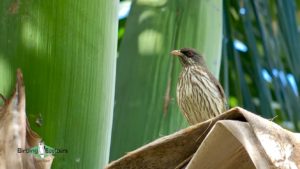 A striking Palmchat, the national bird of the Dominican Republic.
A striking Palmchat, the national bird of the Dominican Republic.
Overview
This tour had been scheduled for nine days; unfortunately our client (Shailesh) decided to cut the trip short due to concerns regarding the spread of COVID-19, so the trip was quickly rerouted and sped up in an attempt to get as many of the target species as possible. The tour began in Santo Domingo, the capital of the Dominican Republic, on the 13th of March 2020 and finished back there on the 18th of March. The rerouted tour’s focus was to visit the main birding spots on the island, namely the National Botanical Garden in Santo Domingo, Los Haitises National Park, and Sierra de Bahoruco.
Despite this the tour connected with many exciting and endangered birds, such as the greatest success story on the avian side, the Critically Endangered (IUCN) Ridgway’s Hawk (Buteo ridgwayi), and other amazing endemics species in the Dominican Republic, including Ashy-faced Owl, White-fronted Quail-Dove, the rare Bay-breasted Cuckoo, Hispaniolan Trogon, Broad-billed and Narrow-billed Todies, Antillean Piculet, Hispaniolan Amazon (Parrot), Hispaniolan Parakeet, Flat-billed Vireo, the declining Golden Swallow, Rufous-throated Solitaire, the rarest and highly prized La Selle Thrush, Hispaniolan Crossbill, Antillean Euphonia, Western Chat-Tanager, and the two endemic warblers Green-tailed and White-winged Warblers, along with Hispaniolan Spindalis and Hispaniolan Oriole, and the national bird of the country, Palmchat.
A total of 100 bird species were seen, and two additional species were heard only. The species list is at the end of this report.
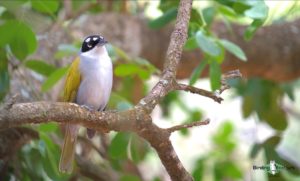
Detailed Report
Day 1, 13th March 2020. Santo Domingo
After arriving in a busy Santo Domingo we checked into our hotel in the old colonial district (Zona Colonial). We then decided to enjoy an evening walk through the colonial district, during which we saw the first two endemic birds, Palmchat and Hispaniolan Parakeet, and the Caribbean specialties Antillean Palm Swift and Grey Kingbird, along with other species like many Bananaquits, House Sparrow, Brown Pelican, Northern Mockingbird, and Mourning Dove.
Day 2, 14th March 2020. National Botanical Garden, transfer to Los Haitises National Park
Within the first five minutes after stepping through the entrance of the National Botanical Garden we had seen huge colonies of Palmchats and Antillean Palm Swifts, followed by the first of many Hispaniolan Woodpeckers, Antillean Mango, Common Ground Dove, and Mourning Dove. Hispaniolan Lizard Cuckoo was calling all morning and making it difficult to actually see it, but eventually we had a great view. Soon afterwards the soft call of Broad-billed Tody caught our attention, and it showed well.
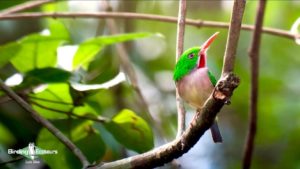
Then we found Vervain Hummingbird, the second-smallest bird in the world, feeding along a trail. The end of our birding the gardens delivered the main target of the morning, West Indian Whistling Duck, for which this is one of the best localities, along with Green Heron, Snowy Egret, Common Gallinule, and Spotted Sandpiper. Some exploration in the woods produced Red-legged Thrush, Black-crowned Tanager (Palm-Tanager), Ovenbird, Black-and-white Warbler, and American Redstart. After a good morning’s birding and introduction to the country’s birds we transferred to the Los Haitises National Park at the eastern side of the country. After we checked into our comfortable accommodation we were able to explore the area and find the rare Ashy-faced Owl.
Day 3, 15th March 2020. Birding Los Haitises National Park, transfer to Puerto Escondido
We started the morning meeting up with the local guide (Juan), who has worked with the Peregrine Fund for the last 30 years and keeps tabs on Ridgway’s Hawk. Juan showed us an active nest with two stunning adults inside the park, Los Haitises National Park is home to and the last stronghold for this country’s rarest endemic and one of the most endangered Caribbean raptors, This species was close to extinction, but, although the fight is not won yet, hard work by the Peregrine Fund has seen this species’ numbers start to increase in the region. Our mourning’s birding in the area also produced many other species, including Limpkin, Plain Pigeon, Ruddy Quail-Dove, Antillean Mango, Greater Antillean Bullfinch, Vervain Hummingbird, Broad-billed Tody, Hispaniolan Woodpecker, Antillean Piculet, Stolid Flycatcher, Black-whiskered Vireo, White-necked Crow, Palmchat, Black-crowned Tanager (Palm-Tanager), Greater Antillean Grackle, and a variety of wintering warblers including Northern Waterthrush, Northern Parula, and American Redstart, among others like Black-and-white Warbler, Western Cattle Egret (Cattle Egret), and Great Egret. We finished birding Los Haitises National Park at noon before transferring southwestward to check into Villa Barrancolí, where we’d spend the night, before we went on a night walk, which produced a vocal Least Poorwill (Least Pauraque), but unfortunately there was a celebration at the village and we couldn’t track the bird.
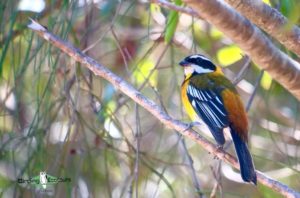
Day 4, 16th March 2020. Birding Zapotén and the Sierra de Bahoruco
We started the morning around 4 a.m. and met with Rafael, a local guide and today’s driver. Our intent was to arrive before sunrise in the montane forest of Zapotén in the Sierra de Bahoruco. The drive up the mountain was incredibly rough, but we were able to hear the call of American Barn Owl perched down by a cliff, and as soon as we arrived at Zapotén we started to hear the call of the Hispaniolan Nightjar many times. After we had parked the car we started the best birding day of the tour. Our first main target was the rare La Selle Thrush, and we enjoyed views of two birds as they were feeding one up and one down the road. Then we saw our first Hispaniolan Emerald, Green-tailed Warbler, and Hispaniolan Spindalis before enjoying an amazing view of Hispaniolan Trogon. Hispaniolan Pewee and Greater Antillean Elaenia were really common throughout the morning. We also had a brief view of the skittish Rufous-throated Solitaire, and Narrow-billed Tody became extremely common in the area. The elusive Western Chat-Tanager gave us some great, close-up views before it melted back into the bushes. Later Shailesh was photographing one of our top targets, White-winged Warbler, and we enjoyed some great views of Greater Antillean Bullfinch, while the declining Golden Swallow was flying over and then perched in a tree for great scope views. We also marveled at the beauty of Red-legged Thrush and saw Antillean Siskin, Black-crowned Tanager (Palm-Tanager), Bananaquit, and a good number of migratory warblers, such as Black-and-white Warbler, American Redstart, Cape May Warbler, and Black-throated Blue Warbler. Endemics we found here were Hispaniolan Lizard Cuckoos, White-necked Crow, and Hispaniolan Parakeet. Then one of the most important birds for Shailesh, Bay-breasted Cuckoo, started calling and briefly showed. Subsequently pine trees at the top of the hill delivered an exciting moment with a pair of Red-tailed Hawks and one Sharp-shinned Hawk, and we also enjoyed Hispaniolan Crossbills along with a number of Pine Warblers.
The return trip was quieter, but we did better our views of Greater Antillean Bullfinch and finally saw Antillean Euphonia. The road dawn the mountain provided Stolid Flycatcher, Vervain Hummingbird, and a few of the introduced Olive-throated Parakeets, and a quick stop at one of the military checkpoints produced the regional specialty, Loggerhead Kingbird.
Once we reached the drier woodland near the town we started working this area for a few different species. Rafael called in a Flat-billed Vireo, which fortunately showed well, when the rare Bay-breasted Cuckoo called just behind us, but we couldn’t see it. However, we saw other good birds like Smooth-billed Ani, Ovenbird, Yellow-faced Grassquit, and Hispaniolan Lizard Cuckoo. Then we returned to Villa Barrancolí for a quick late lunch.
We went to the Rabo de Gato trail for the afternoon period, which saw us add a few more species. White-fronted Quail-Dove was the first of our targets we found, and after patiently scanning we spotted a Louisiana Waterthrush feeding by a creek. Some other species seen here included Belted Kingfisher, Scaly-naped Pigeon, White-necked Crow, Hispaniolan Parakeet, and Ovenbird.
Day 5, 17th March 2020. Villa Barrancolí to Santo Domingo
We started birding early. Once again we were briefly looking at the elusive White-fronted Quail-Dove on the Rabo de Gato trail, and scanning the forest floor we found a least three Ovenbirds. While we were focused on the soft call of Ruddy Quail-Dove a beautiful and really cooperative Key West Quail-Dove showed up in the middle of the trail. After breakfast we went to the La Placa sector, the dry woodland of the Sierra Bahoruco, looking for more birds. On the tower we had amazing views of the Antillean Piculet and Hispaniolan Lizard Cuckoo along with many Common Ground Doves, Zenaida Dove, White- winged Dove, Smooth-billed Ani, Grey Kingbird, Stolid Flycatcher, Black-whiskered Vireo, Black-crowned Tanager (Palm-Tanager), American Redstart, and Northern Parula. We returned for lunch to Villa Barrancolí and then checked out and made our way back to Santo Domingo.
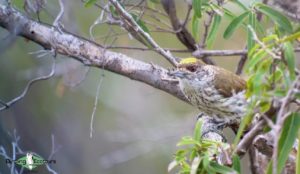
Day 6, 18 March 2020. Departure from Santo Domingo
Finally we concluded an amazing tour, even with the all the concern about COVID-19 around the world. We enjoyed the three main birding spots on the island and found all the main targets for Shailesh. As a result we have great memories of another successful Birding Ecotours tour.
Please see the downloadable PDF above with the full species list included.